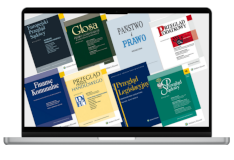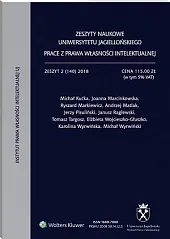Michał Kućka
p. 8
Joanna Marcinkowska
p. 31
Ryszard Markiewicz
Permitted use of protected works as a normative basis for limitation of the protection of moral rights. Self-corrections
p. 50
Andrzej Matlak
p. 60
Jerzy Pisuliński
p. 74
Janusz Raglewski
p. 85
Tomasz Targosz
p. 94
Elżbieta Wojcieszko-Głuszko
p. 121
Karolina Wyrwińska
A few comments about the sharing economy in a context of Open Science vision and Creative Commons tools
p. 137
Michał Wyrwiński
Suspension of enforcement of the duty to publish ‘apologies’ for infringements of personality rights before fi ling a cassation appeal
p. 143
Michał Kućka
Once again on the constitutionality of Article 79(1)(3)(b) of the Polish Copyright Act. Remarks against the background of Constitutional Tribunal judgment of 23 June 2015 (SK 32/14)
Article 79(1)(3)(b) of the Polish Copyright Act was declared partially unconstitutional by a judgment issued on 23 June 2015 by the Constitutional Tribunal (SK 32/14), in so far as that provision permitted a person whose author’s economic rights were infringed to claim, in the event of a culpable infringement, the payment of a sum corresponding to thrice the amount of the appropriate fee.
Since the judgment the provision has not been amended, even though the effects of the Tribunal’s judgment are vague (it has been differently interpreted by courts and legal scholars). It is unclear what impact the Tribunal’s judgment has on the part of Article 79(1)(3)(b), which is still in force. Moreover, it is uncertain whether the judgment can infl uence other regulations concerning the fl at-rate compensation in the Polish private law (e.g. penalty or liquidated damages).
In the article, it is argued that the unconstitutionality of Article 79(1)(3)(b) concerned not only the amount of the fl at-rate damages (thrice the amount of the fee due), but also the mechanism itself. That is why since 1 July 2015 (the day when the judgment became effective and Article 79 partially ceased to be in force), Article 79(1)(3)(b) of the Polish Copyright Act – in the part which is still binding – should be interpreted with due consideration for the Tribunal’s judgment. This means that a rightholder whose economic rights have been infringed may seek redress for the loss sustained on the basis of general principles or may seek payment of a sum of money corresponding to twice the amount of the appropriate fee (even if the infringement is not culpable, which is also disputable, because it is a ‘penalty without guilt’). However the burden of proof should be on the rightholder, who should establish that the facts of the given case justify the award of damages under Article 79(1)(3)(b) of the Polish Copyright Act and that it is accordingly ‘appropriate’ to do so. It must, as a minimum, either be ‘diffi cult to determine the amount of the actual loss sustained’ or there must be grounds to establish that the award of damages limited to a sum calculated by reference to subparagraph (a) of this provision is manifestly unjust or unreasonable.
The judgment of 23 June 2015 rebutted the presumption of constitutionality of Article 79(1) (3)(b) of the Polish Copyright Act and therefore, in order to meet the standards introduced by the Constitutional Tribunal, courts should award rightholders twice the amount of the royalties normally due only on a case-to-case basis. However it must be emphasised that the rightholder must prove the loss (but not the precise amount of it) and the causal link between the event which infringed his rights and the loss. The fl at-rate compensation can by no means be considered as a back door to punitive damages.
Back to top
Joanna Marcinkowska
Non-contractual use of a computer program by the State Treasury – general comments
The issue of administering author’s economic rights in computer programs is generally regulated by the Act on Copyright and Related Rights and, additionally, by the Civil Code. It is worth recalling that computer programs are particularly ‘sensitive’ types of works, for which the application of some general provisions of the Copyright Act, such as certain forms of permitted use or even some contractual solutions, has been limited. In the amendments to the Law on the System of Common Courts passed in July 2017, the legislator introduced an extraordinary solution (Art. 175f), which allows the State Treasury to acquire, under an administrative decision, author’s economic rights to computer programs used to operate the IT systems of courts. This regulation is chaotic, imprecise and its wording gives rise to many questions. Above all, it is not clear whether the decision results in the transfer of rights, expropriation or the grant of a compulsory license. In the following research paper, this solution is discussed in general terms from the perspective of copyright law, constitutional law, public procurement law, and the relevant provisions of the Berne Convention.
Back to top
Andrzej Matlak
Communicating television broadcasts to the public in places accessible against payment of an entrance fee as a separate fi eld of use
An analysis of the regulations resulting from international conventions, EU law and national legislations shows that the scope of exclusive rights granted to holders of neighbouring rights is narrower than the scope of copyright in various kinds of works. A special example is the right to air broadcast of radio and television organisations. One of the fi elds of use within the scope of this neighbouring right is communicating TV broadcasts to the public in places accessible against payment of an entrance fee.
The article discusses the regulations on ‘communicating television broadcasts to the public communicating in places accessible against payment of an entrance fee’ resulting from the Rome Convention of 1961, the directives applicable in the EU and the Polish Act on Copyright and Neighbouring Rights. There is also a detailed analysis of the judgment issued by the Court of Justice of the European Union on 16 February 2017 in case Verwertungsgesellschaft Rundfunk GmbH v. Hettegger Hotel Edelweiss GmbH (C 641/15), concerning communicating of TV broadcasts to the public in hotel rooms. In this judgment the Court stressed that the scope of the right of communication to the public provided for in Art. 8(3) of Directive 2006/115 was the same as the scope of the right resulting from Art. 13(d) of the Rome Convention (limited to ‘places accessible against payment of an entrance fee’). The intention behind the EU directive was largely to copy the provisions of the Rome Convention, which establishes the minimum required level of protection, in order to achieve uniform (minimum) protection required across the EU (including by guaranteeing an exclusive right to communicate TV broadcasts to the public under the conditions set out in the Rome Convention). The CJEU has pointed out that the condition stipulated in Art. 13(d) of the Rome Convention, concerning the payment of an entrance fee, presupposes that the fee is requested specifi cally in return for a communication to the public of a TV broadcast and that consequently amounts paid for a meal or drinks in a restaurant or in a bar where TV broadcasts are aired is not regarded as a payment of an entrance fee within the meaning of that provision. Accordingly, the CJEU has assumed that the price of a hotel room is not – like the price of a meal – an entrance fee requested specifi cally in return for a communication to the public of a radio or television broadcast, but constitutes the consideration for, principally, the accommodation service, to which, according to the hotel category, certain additional services are added, such as the communication of broadcasts by means of receiving equipment in the rooms, and the price of such services is normally included in the price of the overnight stay and not mentioned as a separate item. Consequently, even though distribution of a signal by means of TV and radio sets installed in hotel rooms constitutes an additional service which has an infl uence on the hotel’s standing and, therefore, on the price of rooms, it cannot be considered that that additional service is offered in a place accessible to the public against payment of an entrance fee within the meaning of Art. 8 (3) of Directive 2006/115.
Back to top
Jerzy Pisuliński
Software licence and disposition of a thing
An increasing number of everyday things surrounding us come with embedded computer programs. Those programs not only ensure the operation of specifi c sub-assemblies, but also enable the manufacturers or sellers of those things to offer of additional functions or additional services. This paper will attempt to answer two questions: 1) what is the legal relationship between the buyer of the thing and the holder of copyright in the software embedded in that thing and 2) whether a third party, to whom the buyer of the thing decides to sell it or to transfer it for use, acquires any rights in the program installed in that thing and, if so, what rights. The authors considers different options in the case where a computer program has been pre-installed in the thing and such a thing is subsequently sold to another person: a) the buyer of the thing is granted a licence by the holder of copyright in the computer program; b) the buyer of the thing is granted a sub-license by the manufacturer of the thing (the licensee); c) the buyer is allowed to use the program under a statutory licence. The author argues for the last option. The buyer is also allowed to rent such a thing. It seems that in principle it does not enable circumvention of the right to control further rental of the program or copies thereof, which right is vested in the holder of copyright in such a program.
Back to top
Janusz Raglewski
Prosecuting perpetrators of offences defi ned in the Act on Copyright and Related Rights (several remarks from a defence lawyer’s perspective)
The analysis presented in this short article focuses on selected issues related to criminal liability for criminal acts penalised in the applicable Act on Copyright and Related Rights from the perspective of a defence lawyer. The prosecution of perpetrators of this type of offences requires overcoming many diffi culties. They have grown, especially in the face of the emergence of new technologies, which constitute a signifi cant challenge for the traditional juridical formulas of criminal law.
Back to top
Tomasz Targosz
Personality rights infringements on the Internet – a revolution in case law
This article deals with two seemingly unconnected topics. The fi rst is whether placing a link to content infringing third party personality rights should be in itself regarded as an infringement. Polish courts addressed this issue relatively early in a well-known decision of the Court of Appeal in Kraków. In this decision, thoroughly analysed by Karolina, the Court held that placing such a link could amount to an infringement as it made the infringing content available to a greater number of people. The issue of the legal signifi cance of providing links returned in a series of CJEU’s decisions on the scope of the right of communication to the public in copyright law, such as Svensson or GS Media cases. The reasoning applied by the CJEU differed from the one initially adopted by the Court of Appeal in Kraków in that the increase in the number of persons who actually got access to the linked content was deemed irrelevant. Instead, the CJEU developed a rather dubious criterion of a ‘new public’. While it is not necessary to apply the same criteria to linking in copyright law and in non-harmonised civil law governing the protection of personality rights, it is nevertheless tempting to follow the same principles, one obvious reason being the coherence of the national legal system. The problem can be, however, approached from a different angle. One could ask what an ‘infringement’ of a personality right really means. This issue has so far attracted surprisingly little attention from the courts and legal commentators, but interestingly a decision dealing with it was also issued with respect to the internet environment. The Polish Supreme Court applied a very wide understanding of the term ‘infringement’, whereby any action that eventually results in an infringement may be found illegal. Under this approach links could be considered infringements in their own right. What the Supreme Court failed to notice was that such a broad understanding of ‘infringement’ could not exist without some limiting instruments, especially the concept of duty (of care) that must be violated by the defendant. Otherwise the scope of liability would be intolerably broad. This addition of the duty of care may also help solve the fi rst problem: placing a link to infringing content can constitute an infringement only when the person providing the link has failed to apply the required degree of care. Because of how ubiquitous links are, those who provide links cannot be burdened with an excessive obligation of verifying the legality of the linked content. Links to infringing content should therefore be considered infringing only in the rare cases when the party providing them clearly ‘makes the linked content its own’ or disregards its obvious unlawfulness.
Back to top
Elżbieta Wojcieszko-Głuszko
Presentation of a trademark in the application − selected issues
This article discusses the issue of an adequate representation of a trademark (in particular an unconventional trademark form, such as shape, colour per se or a combination of colours without delineated contours, sound, position, hologram or motion) in the application for a protective right, as one of the key factors for determining the scope of the protection sought. The evaluation of the rules for presenting a trademark in the application in the context of Rule 3 (4–9) of the Regulations under the Singapore Treaty on the Law of Trademarks (as in force on 1 November 2011), by which Regulations Poland is bound, reveals the need for further modifi cation of the analysed provisions of § 6 of the Regulation of the Prime Minister of 8 December 2016 on the fi ling and processing of trademark applications, which came into force on 24 December 2016 (Polish offi cial journal Dz. U. 2016, item 2053). The need for legislative amendments is pointed out. They are necessary to ensure an adequate level of presenting trademarks with greater precision, thus facilitating the perception of non-conventional trademarks by consumers.
Back to top






